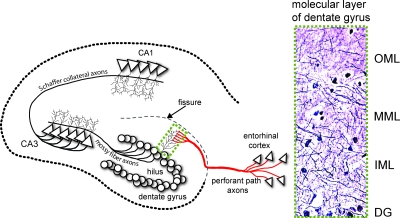Figure 1.
ECL in the rodent brain are a model for the perforant path degeneration in AD, which damages a major input from the cerebral cortex to the hippocampus, a key center of declarative memory. Perforant path axons arise from large neurons in layers II and III of the lateral entorhinal cortex (EC) and project to dendrites of granule cell neurons in the outer molecular layer (OML) of the dentate gyrus (DG). The hippocampal fissure is an embryonic remnant that physically separates the dentate gyrus from the dendritic field of CA1 neurons. The granule cell axons (mossy fibers) project to CA3 pyramidal neurons, which in turn send Schaffer collateral axons to CA1 pyramidal neurons. These three links comprise the trisynaptic circuit of the hippocampal memory module. Degeneration of EC neurons and perforant path axons arises early in AD, whereas the granule and CA3 neurons are relatively spared throughout AD. After unilateral ECL, compensatory sprouting (reinnervation) within the molecular layer of the dentate gyrus arises from multiple pathways; the commissural/associational axons innervate the inner molecular layer (IML), and axons from the septohippocampal pathway, from the contralateral EC, and from local interneurons sprout to innervate the outer molecular layer (OML). Inset shows Holmes axonal fiber stain.

